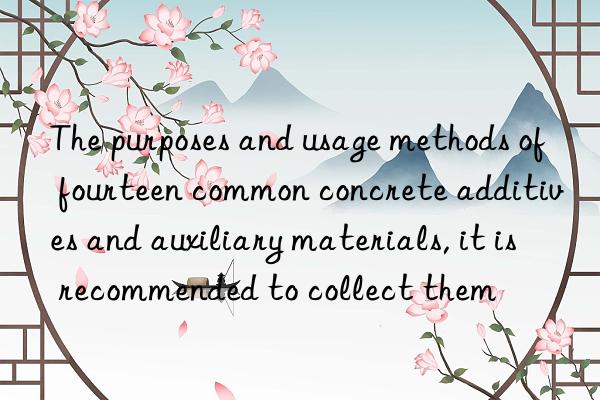
Concrete admixtures can enhance the performance of concrete, and can also be added to obtain concrete that is more suitable for use. Below are fourteen commonly used concrete additives and auxiliary materials, and a brief introduction to their uses and how to use them!
1. Self-leveling adjustment water retention agent
Use dry large flow concrete to solve concrete problems. Unreasonable gradation of sand and stone, excessive stone powder, machine-made sand, base glue, bleeding, slurry, exposed sand and exposed stone in low-grade and large-flow concrete, and waterline workability after pumping concrete has set. It is different from traditional cellulose and dextrin. This product has good mutual solubility with the water-reducing agent system and will not stratify or deteriorate at different temperatures. It is recommended to add 5~20kg per ton of 10% polycarboxylic acid finished product.
2. Machine-made sand conditioner (liquid, powder)
Uses: used Machine-made sand concrete can be opened, but has poor workability, poor slump retention, less slurry, exposed stone, and bottoming. Improve its overall performance. It is recommended to add 20~40kg per ton of 10% polycarboxylic acid finished product
3. Mud inhibitor (liquid, powder)
Used in water-washed sand, mountain sand, stone powder, artificially crushed sand, and glue materials with large mud content to ensure that they can be opened and held securely, repel cement particles, and disperse the slurry. Equal or excessive replacement of ethers allows the polycarboxylate water-reducing agent and slump-retaining agent to play a regular role in actual work, so there is no need to significantly increase the amount of water-reducing agent to achieve dispersion. It is recommended to add 10~30kg of polycarboxylate water-reducing agent with a solid content of 10% per ton
4. Low-temperature early-strength antifreeze
Anti-freeze early strength, effectively improves early strength at 1 day, 3 days, and 7 days, has no impact on later strength growth, and has good frost resistance. It is recommended to add 5-20kg per ton of 10% polycarboxylate water reducing agent
5. Concrete viscosity reducer
Used for high-grade concrete, low-grade concrete containing a lot of stone powder, mortar, and grouting materials. It is recommended to add 20~40kg of polycarboxylate water-reducing agent with 10% solid content per ton
6. Concrete anti-flocculating agent
Used in water-washed sand, it can effectively degrade and neutralize the effects of Juqing-containing flocculants on the dispersion, slump retention and strength of concrete. It is recommended to add 20~40kg of this product per ton of polycarboxylate water-reducing agent with 10% solid content.
7. Concrete anti-segregation agent
Used for concrete with large slump segregation. The control effect is good and the dosage range is wide. It is suitable for the driver to adjust on the construction site without having to back off the vehicle. It will not affect the strength, setting time and color difference of the segregated concrete. This product is a powder. It is recommended to add 0.5-1kg per cubic meter of concrete and mix thoroughly in the mixer truck for more than 3 minutes.
8. Super retarder
Used in high temperature (above 35℃) environment, It has wide adaptability to materials and will not cause false coagulation. It can delay the final setting of concrete for more than 18 hours without affecting the later strength. It is recommended that the cost of adding 10% polycarboxylic acid is 10~60kg/.
9. Polycarboxylic acid high-efficiency air-entraining agent
Good foaming and foam stabilizing properties , the foam size is adjustable and has wide adaptability to materials. Reduce the adsorption of water-reducing agents in inferior cementing materials, effectively improve the slurrying properties, workability and impermeability of concrete, and have little impact on the strength of warm concrete. Add 0.5~2.0kg of this air-entraining agent per ton of polycarboxylic acid finished product with 10% solid content (commonly used amount is 0.8~1.5kg); double the amount for 20% solid content. It is recommended to add 1.5~3.0kg per ton of 30% naphthalene series or aliphatic or sulfamate series water reducing agent.
10. Naphthalene-based slump-preserving agent
Cement particles are charged during the later stages of hydration This achieves the purpose of post-dispersion and allows the concrete to gain plasticity, thus delaying the loss of concrete slump and saving the amount of air entrainment and dextrin. It is recommended to add 25~40kg per ton of naphthalene-based water reducing agent with a solid content of 30%
11. Preservatives
Polycarboxylic acid (naphthalene series, etc.) water-reducing agent is antiseptic and can be used for sterilization in combination with polycarboxylic acid, sodium glucose, sugar and other components. Industrial cleaning supplies, emulsified metal processing oil and other anti-corrosion products. The recommended dosage is 0.8~2kg per ton of finished product.
12. Concrete foaming agent
Foaming and stabilizing, used for foaming Concrete lightweight insulation material. Backfill concrete sound insulation materials, 3D printing materials, etc. According to the bulk density or strength requirements of different materials, the added amount ranges from 1% to 10% of the adhesive material.
13. Defoaming agent
Concrete superplasticizer industry, papermaking, Eliminate large foam and stabilize micro foam in industries such as oil refining, coal-water slurry additives, and sewage treatment. It is recommended to add 100-200g per ton of finished water reducing agent.
14. Modified rosin air-entraining agent
Changing the traditional macromolecule rosin air-entraining agent It eliminates the disadvantages of high viscosity and poor water solubility of the agent, forming small and dense bubbles and good micro-foam stability. Improve the workability and impermeability of concrete. It is recommended to add 2~4kg of this product per ton of finished water reducing agent.
</p



 微信扫一扫打赏
微信扫一扫打赏
